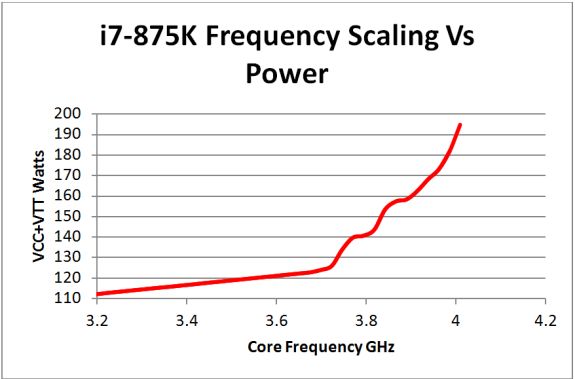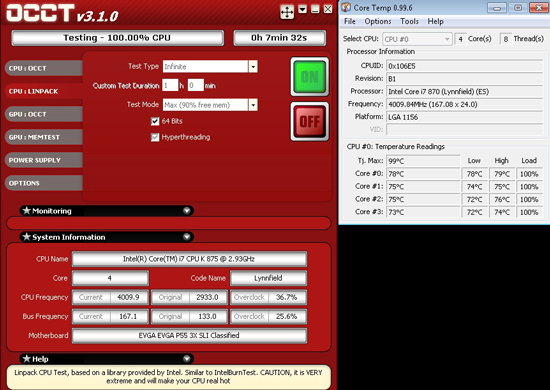Intel’s Core i5-655K & Core i7-875K: Overclocked and Analyzed
by Rajinder Gill on May 28, 2010 5:00 AM ESTOk, so we got a little carried away on the Clarkdale stuff. Time to give the i7-875K a look-see. After all, it’s probably the bigger story of the K-series release given it offers more overclocking features and a similar stock clock speed to the more expensive i7-870.
No beating around on this one, we started off with watercooling:
Without water-cooling, there isn’t much headroom at all - at least not on this sample. Our i7-870 ES manages 4.4GHz, pulling 201 Watts during Linpack. The 875-K is already at 193 watts, and it has barely broken 4GHz. Past 3.9GHz, we’re already looking at a 10W increase in power consumption for every 20 MHz rise in CPU frequency - let’s just say that this did not encourage us to push any further. Well, that’s not completely true because we did try it out under our cascades. Unfortunately, things are pretty bad in the sub-zero realms, too. The substrate can’t handle more than 1.35Vcore when cooled below -70 Celsius, making it a difficult chip to control and one that’s ultimately limited in headroom. The best we managed was a run of Vantage at 4.5GHz, which really isn’t worth bragging about.












51 Comments
View All Comments
Rajinder Gill - Saturday, May 29, 2010 - link
Hi,I ran out of time to test any further unfortunately. The emphasis was kept on air/water cooling because it's practical to run 24/7.
Regards
Raja
TheBLK - Saturday, May 29, 2010 - link
I'll ask again. Unless the screen shots are wrong you used BLK clock to over-clock rather than multiplier on the chip.Other reviews kept the BLK at the same value and just used the multiplier and seemed to get higher results.
Rajinder Gill - Saturday, May 29, 2010 - link
Yes I did on the 655-K stock VID (added 2 BCLK because the next multiplier up was too far (133 multiples in frequency is a large jump) :http://www.anandtech.com/show/3742/intels-core-i56...
Also describe why BCLK overclocking is not the way to go on the 655K for performance:
http://www.anandtech.com/show/3742/intels-core-i56...
Finally the 855K - this chip is limited to 4GHz even on water cooling. BCLK overclocking is not going to change that. 167 BCLK at DDR3 1670 is nowhere near stressful for the Lynnfield IMC. Multiplier overclocking is NOT going to make any difference to the clock speed limitation.
-Raja
Rajinder Gill - Saturday, May 29, 2010 - link
Just for you :)http://img7.imageshack.us/f/linpackfailj.jpg/
That is all the water loop can handle (the chip is drawing over 190W). I can drop the multiplier down to 30 (but then we are back to 4GHz).
Hope this helps!
Regards
Raja
DJMiggy - Thursday, June 3, 2010 - link
It seems like you guys used the wrong motherboard or got a dud i7. Other reviewers don't seem to be having as tough a time overclocking these higher.Rajinder Gill - Friday, June 4, 2010 - link
The motherboard is EVGA's E659 - works fine with my i7 870 ES taking it to 4.4GHz Linpack stable. It's the CPU that is the limiting factor here. Bear in mind that not all articles you've read will have stability checked stability with Linpack as well.Later
Raja
DJMiggy - Friday, June 4, 2010 - link
That makes sense. Cool thanks! I appreciate the explanation.ReaM - Saturday, June 5, 2010 - link
I must say, what a crappy K-series! I can bring every i7 860 up to 4ghz. I have tested many of them, so there is really no reason to put any hope into these Ks. Just buy a regular one.My personal sample of 860 runs @ 4200 with 1.29V on air Noctua U12 with low temps.
ReaM - Saturday, June 5, 2010 - link
Did you put Load Line Calibration into LVL2?I don't know what's that called on EVGA. Enhanced Power Slope. VDrop Adjustment. Lynnfield, unlike Bloomfield, likes their load line to be adjusted.
Rajinder Gill - Sunday, June 6, 2010 - link
Makes no difference to the stability of this chip.